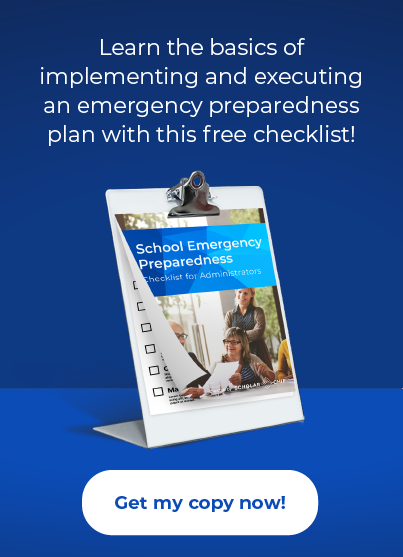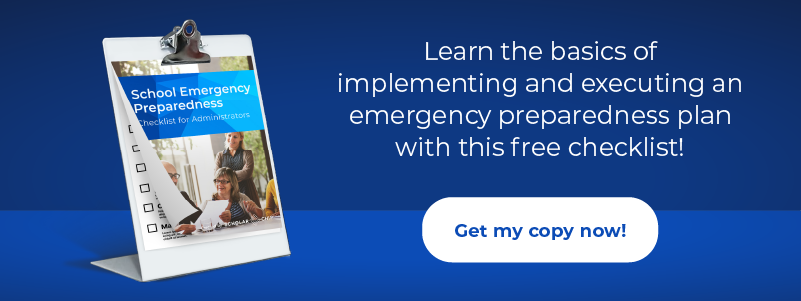Parents and communities expect schools to provide a safe and healthy environment for students. To keep students safe, your school must have a plan of action in the event of a fire, a natural disaster, an attack, and even a pandemic. An emergency operations plan includes everything from educational continuity and contingency to physical safety from violence.
Having a well-thought-out safety plan outlines the roles of the school and staff, the community, and the local government. To truly be prepared for any event, however, you’ll need to regularly practice elements of your emergency plan and keep it current and relevant.
Why an Emergency Operations Plan Is So Important
Schools should be a haven for students. Parents must feel confident that the administration and staff have the care and protection of their children top of mind at all times.
To ensure that remains the case, administrators must have plans to prevent, prepare, respond, and recover from a wide variety of situations, including snowstorms, issues with school utilities, and fires. They must also take into account less likely threats, such as attacks or an epidemic.
An emergency operations plan clarifies the responsibilities of the administration, staff, and even external resources. It also plots the actions that should be taken in the event of an emergency. Essentially, it is a blueprint for practicing emergency responses.
Your school’s plan should include elements such as communication with first responders and parents, how to account for students during the crisis, and who is responsible for specific actions during an event. A reliable emergency plan includes crisis management for the entire timeline of a situation: before, during, and after.
Now is the perfect time to revisit your emergency operations plan. Every school has learned if their plan served them well during COVID-19 shutdowns and what areas need improvement. It’s time to seize the moment and look at your emergency plan with a fresh perspective.
How COVID-19 Has Changed School Emergency Plans
The uncomfortable truth is that the coronavirus uncovered a gaping hole in most school’s emergency operations plans. Schools were unprepared or underprepared for teaching remotely at all, let alone for an extended period of time.
It’s critical to incorporate a pandemic response into your plan. Doing so now will allow you to employ the lessons learned only months ago. Your emergency response should include how to manage periods where most students are ill, whether for a short time or a long time, like weeks or months.
To do this, schools need to account for remote learning needs. Having the tools and technologies already in place will make the transition smoother. These plans must also have contingencies for students who don’t have ready access to the Internet.
In addition, prevention and mitigation plans must be considered. This includes actions for preventing the spread of illness and employing health services to mitigate the impact of an epidemic. You won’t be able to go back in time to gather information or data that you need amid a crisis.
Incorporating visitor management and tracking as part of your planning will give your school the records it may need for contact tracing. Visitors can be identified, mapped against infection timelines, and alerted if they were in contact with infected individuals.
Implementing and Executing Your Emergency Plan
Just as your school is part of a larger community, your emergency plan doesn’t exist in a vacuum. Implementing an emergency operation plan requires collaboration and a concentrated effort to articulate it clearly for all participants.
The US Department of Education’s Readiness and Emergency Management for Schools (REMS) outlines the following six steps to create your plan, with implementation and maintenance being the final step:
- Form a collaborative planning team.
- Understand the situation.
- Determine the goals and objectives.
- Plan development.
- Plan preparation, review, and approval.
- Plan implementation and maintenance.
The implementation of your plan should include training for stakeholders and those with any of the outlined responsibilities. Education of students, staff, and parents is another element of implementation, as is practicing the various parts of the plan.
Maintaining your plan will require regular reviews by the planning team. You should collaborate with community representatives and government and safety officials, as well as first responders, to ensure that the plan includes a diversity of experience and perspectives.
Reviewing and practicing your plan keeps the steps fresh in the minds of those responsible. If a plan must be called into action, practice will prevent missteps in an actual emergency and eliminate questions during the event.
Regularly reviewing and updating your emergency operations plan will allow you to change it to incorporate new information, experiences, and technologies. For instance, your current plan might be improved by having more accurate attendance information. Funds could then be allocated from your emergency preparedness budget to acquire an attendance system that tracks students across their school day.
A school’s emergency operations plan needs to be a living document that is updated and reviewed regularly. It must reflect current threats and dangers to the school population and educational continuity. Our current global situation has made it clear that many of these plans may not be as ready as we think. Admins must take into account evolving information, processes, and technology. With a comprehensive and collaborative plan in place, schools will be in a better position to protect students, maintain continuity, and keep the community informed during a crisis.


